| Srl | Item |
| 1 |
ID:
161644
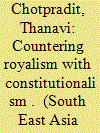

|
|
|
|
|
| Summary/Abstract |
The Boworadet Rebellion in October 1933 brought brutality into the heart of Thailand’s politics. It was followed by a proliferation of commemorative practices focusing on the commoners who sacrificed their lives for the country. In the aftermath of the incident, the search for an appropriate language of loss involved the making of a new meaning of national sacrifice and what it was to be a good citizen. This article considers the nationalisation of death, as manifested in the commemorative visual forms of the crematorium for the 17 soldiers and police officers at Sanam Luang and the Safeguarding the Constitution Monument in Lak Si District. It concentrates on the appropriation of royal inheritance by the People’s Party and the transformation of phan ratthathammanun (a Book of the Constitution on an ornate double tray), which first appears in an anti-royalist context after the revolutionaries suppressed the Boworadet Rebellion. The presence of phan ratthathammanun in this context marks the separation of constitutionalism from royalism and establishes it as a stand-alone symbol of a supreme ideology worth dying for. This article analyses the visual culture of the period following the Boworadet Rebellion in relation to the formation of the Boworadet Rebellion war memory, the new ideology of constitutionalism and the new identity of the Thai people as citizens of the nation instead of subjects of the King.
|
|
|
|
|
|
|
|
|
|
|
|
|
|
|
|
| 2 |
ID:
189184
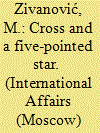

|
|
|
|
|
| Summary/Abstract |
AFTER the end of the Jassy-Chisinau operation that liberated Romania and Bulgaria in September 1944, Red Army units reached the border of the former Yugoslavia. On September 28, a major offensive began that resulted in the liberation of Belgrade on October 20. The offensive was followed by military operations to cross the Danube River and take and hold the bridgehead, known as the Battle of Batina (the biggest battle in Yugoslavia during World War II), and then battles on the Syrmian Front, which was broken in April 1945.
|
|
|
|
|
|
|
|
|
|
|
|
|
|
|
|
| 3 |
ID:
156106
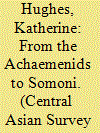

|
|
|
|
|
| Summary/Abstract |
This article focuses on the iconicity of contemporary Dushanbe’s capitol complex, with its state-sponsored architecture and memorial culture, part of the government of Tajikistan’s national identity construction. Dushanbe’s architecture post-independence is actant, a mnemonic and iconographical bridge between the present and favoured historical periods in a quest for national origins. A bricolage of historical symbols, including those of Achaemenid Iran and the early Islamic Samanids, is displayed here in a city with Soviet foundations. Together with pan-Iranian iconography is a desire by the government of Tajikistan for monumentality for its own sake. The capitol complex evokes the natural world, connected to a Central Asian conception of sacred space, suggesting an interlacing of power and religious authority. These monumental building projects are taking place against the backdrop of the destruction of Dushanbe’s ‘authentic’ Soviet architecture and built heritage in the capitol complex, itself a container for collective memory.
|
|
|
|
|
|
|
|
|
|
|
|
|
|
|
|
| 4 |
ID:
187159
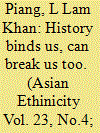

|
|
|
|
|
| Summary/Abstract |
Monuments with inscriptions have always been an important source of history and are helpful for reconstructing the past. They recreate collective memories, as they were erected to commemorate significant events from the past. The historical process of state formation, especially among the former colonies, has bound different ethnic communities, which obliges them to initiate state nation-building processes. So, memories which are recreated, remembered, and forgotten have played a crucial role in shaping ethnic relations as well as relations between the state and various ethnic communities in a multi-ethnic state. This paper analyses the allegation about the Manipur’s Chibu stone inscription as a fabricated historical event, and the complaint asking that its status as a protected archaeological site be denied. It argues that in the name of the state nation-building project, the state has resorted to recreating collective memories with little consideration to the sentiment of ethnic minorities in a state.
|
|
|
|
|
|
|
|
|
|
|
|
|
|
|
|
| 5 |
ID:
162470
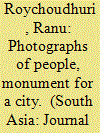

|
|
|
|
|
| Summary/Abstract |
In the late 1970s, a photo-documentation project titled ‘People of Calcutta’ aimed at bringing about positive social change through imaging the everyday lives of ordinary Calcuttans. These photographs responded to a post-colonial situation and created a ‘counter-narrative’ of the agency of the urban poor. Weaving together photographs and their intellectual history, this paper charts the ways in which this visual documentation invested deeply in human development while providing a ‘positive image’ of the urban poor.
|
|
|
|
|
|
|
|
|
|
|
|
|
|
|
|
| 6 |
ID:
101258
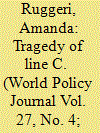

|
|
|